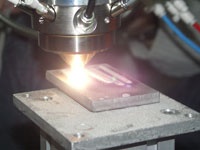
What is surfacing/additive manufacturing and what are its benefits?
Surfacing, often also called additive manufacturing, makes it possible to quickly and cost-effectively produce components whose properties (dimensions, geometry, weight, etc.) make them difficult or sometimes impossible to manufacture using other methods. This offers huge potential, not least for industries where there is considerable demand for smaller production runs of specialist components.
How does surfacing/additive manufacturing work?
The word “additive” in the name of this manufacturing method indicates that the product is manufactured by adding layer after layer on top of each other. In this process, either wire or powder is continuously being added by melting it with a laser beam. In this way it is also possible to coat, add elements, or repair products. The laser beam heats up the additive – the wire or powder – to produce a product with dual material properties.
A soft and/or tough base material with hard and durable surfacing, for example. A robot is used to position optics and additives. The robot program controls the geometry, the additive is melted layer by layer, and the new structure is built up. The process is quick and efficient and can build many kilos per hour.
Surfacing using lasers and wire has the highest deposit rate of all the AM methods. Another benefit of lasers and wire is the aesthetics of the surface, which can be retained on the finished product. A powder bed makes the surface more coarse-grained.
What are the benefits of surfacing/additive manufacturing?
Surfacing/additive manufacturing makes it possible to quickly produce components that are easy to customise in terms of their design and materials. This offers great opportunities in the manufacturing industry in general, and the automotive and aerospace industries in particular. Large expensive castings that are difficult to customise can be replaced, as lighter customised products can be produced quickly and efficiently. This, in turn, has major benefits for manufacturers, customers, and the environment in general. Tools, components, and devices that are no longer produced can be re-manufactured if required.
Surfacing/additive manufacturing also results in very low material consumption thanks to production using powder or wire (with minimal waste). Consequently, large blocks of additives do not need to be manufactured, shipped, and stored before being used with large amounts of wastage.
The technology is mature and easy to automate with low costs and high levels of availability.

